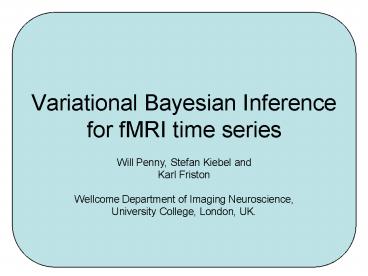Variational Bayesian Inference for fMRI time series PowerPoint PPT Presentation
Title: Variational Bayesian Inference for fMRI time series
1
Variational Bayesian Inferencefor fMRI time
series
- Will Penny, Stefan Kiebel and
- Karl Friston
- Wellcome Department of Imaging Neuroscience,
- University College, London, UK.
2
Generalised Linear Model
- A central concern in fMRI is that the errors from
scan n-1 to scan n are serially correlated - We use Generalised Linear Models (GLMs) with
autoregressive error processes of order p - yn xn w en
- en ? ak en-k zn
- where k1..p. The errors zn are zero mean
- Gaussian with variance s2.
3
Variational Bayes
- We use Bayesian estimation and inference
- The true posterior p(w,a,s2Y) can be
approximated using sampling methods. But these
are computationally demanding. - We use Variational Bayes (VB) which uses an
approximate posterior that factorises over
parameters - q(w,a,s2Y) q(wY) q(aY) q(s2Y)
4
Variational Bayes
- Estimation takes place by minimizing the
Kullback-Liebler divergence between the true and
approximate posteriors. - The optimal form for the approximate posteriors
is then seen to be q(wY)N(m,S), q(aY)N(v,R)
and q(1/s2Y)Ga(b,c) - The parameters m,S,v,R,b and c are then updated
in an iterative optimisation scheme
5
Synthetic Data
- Generate data from
- yn x w en
- en a en-1 zn
- where x1, w2.7, a0.3, s24
- Compare VB results with exact posterior (which
is expensive to compute).
6
Synthetic data
True posterior, p(a,wY)
VBs approximate posterior, q(a,wY)
VB assumes a factorized form for the posterior.
For small a the width of p(wY) will be
overestimated, for large a it will be
underestimated. But on average, VB gets it right !
7
Synthetic Data
Autoregressive coefficient posteriors Exact
p(aY), VB q(aY)
Regression coefficient posteriors Exact p(wY),
VB q(wY)
Noise variance posteriors Exact p(s2Y), VB
q(s2Y )
8
fMRI Data
Event-related data from a visual-gustatory
conditioning experiment. 680 volumes acquired at
2Tesla every 2.5 seconds. We analyse just a
single voxel from x 66 mm, y -39 mm, z 6 mm
(Talairach). We compare the VB results with a
Bayesian analysis using Gibbs sampling.
Modelling Parameters YXwe 9 regressors AR(6)
model for the errors VB model fitting 4
seconds Gibbs sampling much longer !
Design Matrix, X
9
fMRI Data
Posterior distributions of two of the regression
coefficients
10
Summary
- Exact Bayesian inference in GLMs with AR error
processes is intractable - VB approximates the true posterior with a
factorised density - VB takes into account the uncertainty of the
hyperparameters - Its much less computationally demanding than
sampling methods - It allows for model order selection (not shown)

